 Early Civilizations:
Early Civilizations:
 Early Civilizations:
Early Civilizations:
Complex Societies of the New
and Old Worlds
Dr. Kathryn Denning
Anth 2150, Sept 2007 - Apr 2008
13 Nov 2007...
Welcome back!
Plan for the day
1 Announcements.
Last lecture of term: Nov 27
Last tutorial of term: Nov 28
QUIZ #3 will be in tutorial on Nov 28. Review guidelines will be posted here soon. The quiz will be on material from the weeks of Nov 6,13, 20, and 27.
Tomorrow in tutorial -- you'll see, close-up, various hominid skulls. (If you go to tutorial having done the reading for the past two weeks, you'll learn more from this exercise.)
2 Lecture
More on our hominid ancestors.... Modern humans settle the world ... and starting Ronald Wright's book A Short History of Progress.
THE SWEEP OF HUMAN HISTORY
New book - Ronald Wright: A Short History of Progress
Ch 1: Gauguin's Questions
What Are We? Where Do We Come From? Where Are We Going?
If we answer the first two... we might be able to answer the third.
Note: so think again about:
the major developments in world prehistory (Fagan)
- origins of humankind (Homo) around 2.5 mya
- evolution of archaic humans like Homo erectus and then, anatomically modern humans (H. sapiens sapiens) 1.9 mya to 15 000 years ago
- the spread of anatomically modern humans throughout the Old World and the Americas, a process ending 15 000 years ago (people keep moving around but we're all AMH now)
- origins of complex forager societies, of agriculture and animal domestication (food production), after about 11 000 years ago, the spread of agriculture
- the development of greater cultural complexity, including civilizations (urbanized, literate, state-organized) around 3100 BC in western Asia, and then elsewhere.
Perspective: Remember (from last week) -- all of human history is a tiny part of the history of the universe and the history of Earth. If the universe came into being on January 1, hominids evolved on Dec 31 around 10:30 pm, and stone tools emerged around 11 pm... and modern civilizations and technology all evolved after 11:59 pm!
"Only about seventy lifetimes, of seventy years, have been lived end to end since civilization began. Its entire run occupies a mere 0.002 per cent of the two and a half million years since our first ancestor sharpened a stone." (Ronald Wright, A Short History of Progress, 2004, p 55)
Note that the pace of change is different now. It has accelerated. Wright points out: Most people throughout history saw almost no change in technology or in their environment during their lifetimes!
Human evolution overall
Becoming Human (Flash) http://www.becominghuman.org/
(Anatomy... hominid profiles)
Historical development of Understanding of Human Evolution
It has long been realized that the key trends in human evolution, i.e. the things that separate us from our ape cousins and ancestors, were...
terrestriality - coming down out of the trees
bipedalism - having to walk on two feet (obligate, not occasional)
encephalization - increase in brain size in relation to body, development of language
civilization - complex technology, moral systems, complex society
But in the earliest days of studying human evolution (up to 1920s), it wasn't known which came first...
- there weren't enough fossils, they weren't well understood, and they weren't securely dated
- Arthur Keith 1895 "Only four individuals to represent the millions and millions of men that must have lived and died in Quaternary times!" (German Neanderthal skull, Pithecanthropus from Java, two Cro-Magnon Belgian skulls) (As opposed to now, when we have MANY)
- so different theories were abundant... but now, the general trends are clear.
Orienting ourselves in terms of Biological and Early Cultural Trends: locomotion, brain, teeth, and tools
What about controversies and differences of opinion among palaeoanthropologists?. This is how this science works:
- we find a fossil
- we reassemble it as best we can
- we analyze it to determine its individual attributes (female or male, age, pathology, etc.), and the fossil's date
- we try to determine its species (what other specimens does it look like... is it similar enough to be placed within an existing species, or is it different enough to warrant a new species name?)
- we carefully compare it to other species and hypothesize about its relationship to other species
- we go and look for more fossils, we try new analytical methods, etc., and we go through the whole process all over again... and we gradually fill in the picture more and more.
All of these stages are difficult, and there is often more than one way to do it. And sometimes we need more data to answer a question definitively.
HOWEVER, the disagreements are usually pretty minor, in the big picture -- e.g. You'll never get a palaeoanthropologist today mixing up an australopithecine with a gorilla or a Neanderthal -- and we definitely know more about human evolution every year.
![]()
By analogy: We already know what the flower looks like. But we're in the process of filling in all the little details.
Although there are occasionally some very interesting and extremely surprising new finds, the general contours of human evolution are now well-drawn. Basic info about locomotion, brain, teeth, and tools (distilled down from many many specimens):

TRENDS in hominid evolution: bipedalism, expansion of brain (cranial capacity), brain complexity, modification of female pelvis, reduction of teeth, face, and jaws, extended period of infant and child dependence, hairlessness...and eventually, apparent increased reliance on meat, emergence of tool use etc.
Bipedalism - changes in knee, foot (esp big toe), pelvis, spine curvature
Early hominids in general had 3 major adaptive problems - being large mammals, terrestrial primates, living in an open, savanna environment
Bipedalism might have been an advantage because: increased ability to see predators and prey, free hands for carrying food and infants, tool use, long distance traveling more efficient. But it does have drawbacks, too... e.g. if you injure one foot. And it's a strain on hips, backs, knees, ankles.
The best hypothesis for the origins of bipedalism is energy-efficiency, and thermo-regulation (maximum breeze, minimum exposure of body surface to sun at noon)
Cranial capacity: Australos - 380 to 550 cc, vs. early Homo 630-640, vs. Homo sapiens sapiens (us!), usually 1300+ cc N.B. this does vary with body size, and the simple size of the brain alone does not mean greater intelligence within a species. Bigger and more complex brains - linked to stone tool making? around 2.5 mya (Oldowan tool industry),
Pre-australo species
Orrorin tugenensis.... around 6 myr
Sahelanthropus tchadensis – Toro-Menalla region of Djurab Desert in Chad, Central Africa, 6-7 mya
Australo Species: new ones being discovered all the time! Most hominid fossils found in Great Rift Valley of East Africa, and also in South Africa. (Ethiopian, Tanzania, Kenya, and S. Africa)
Additional recent finds: A. anamensis, A. garhi, etc.
Gracile: A. africanus (Taung child) was an early discovery, A. afarensis (Lucy) was a big find in the 70s (40% of skeleton!)
Australopithecus africanus – 3 to 2.5 mya, found by Raymond Dart in 1925 at Taung, South Africa
Australopithecus afarensis – about 3.2 mya, Maurice Taieb and Donald Johanson, Hadar, Ethiopia [well, actually, a student named Tom Gray], nicknamed “Dinkanesh” or “Lucy”, pretty clearly bipedal... though some arboreal traits
Laetoli footprints - 3.5 mya, australo, by Mary Leakey
Robust australos: (Paranthropus/Australopithecus boisei, robustus, aethiopicus)
Special note: the debates over species names and relative positioning are heated. Esp. Johanson and Leakey camps.
Fantastic NEW FIND: "Lucy's Baby" -- couldn't have been her baby, but anyway, a juvenile Australopithecus afarensis, also known as the "Dikika baby". Announced last year. 3.3 million years old, about three years of age. Very rare to find juvenile hominid fossils, and this one is quite complete:
http://www7.nationalgeographic.com/ngm/0611/feature6/index.html
http://www.nature.com/nature/focus/hominiddevelopment/index.html#video
Specimen images: http://www.nature.com/nature/journal/v443/n7109/full/nature05047.html
N.b. compare the Dikaka fossil specimen and the popular 'face' which was all over the news.
http://donsmaps.com/images7/lucy2reconstsmh.jpg
Key features of australopithecines
- large degree of sexual dimorphism
- cranial capacity c 500 cc
- bell-shaped occipital region
- moderate to large eyebrow ridges
- marked post-orbital constriction
- flaring zygomatic arches
- large face relative to size of brain case
- relatively large and jutting jaw
- no chin
- large/very large premolars and molars, thick enamel, small canines
- bipedal
- bowl-shaped pelvis
- life expectancy 44 years (?)
- opposable thumbs
Homo species: bigger brains, reduced molars and premolars, ability to make tools, probable possession of some language
2.5 mya onwards: Homo habilis (Olduvai)
Earliest tools seem 2.5 mya but dispute over who made them (A? H?) -- Oldowan tradition, chopper tools and flakes, pretty basic but very useful for cutting plants and also meat (n.b. we only have stone tools -- and what else might they have used?)
1.7 to 1.5 mya: Homo erectus emerges - starting to get very human-like. Significant because these are the first found out of Africa, in Europe and Asia (some have reclassified the African ones as H. ergaster). Early-discovered specimens: 'Java Man', 'Peking Man'. Bigger brain (895-1040 cc), different brain proportions, and larger overall body size (like us). Prominent, projecting brows. Very dense thigh bones. Developed Acheulean tool tradition from 1.5 mya. Clear evidence of big game consumption (hunting? scavenging?) Potential use of fire 1.4 mya, definite use and control of fire for cooking 500 000 BP in China. Also apparent use of basic structures. Language? Could be. Looks like their brains were up to it, at a basic level.
Archaic Homo sapiens
Considerable continuity between H. erectus and archaic H. sapiens in some place....hard to draw the line. (still, decreasing jaw, face, back teeth, cranial capacity)
Special notes about interpreting the fossil and archaeological record
We have to be careful about over-interpreting.... we need to be very aware of the limitations of our data.
e.g. we know that early hominids made stone tools. But there may have also been wooden tools that didn't survive.
e.g. we know that some early hominids ate meat, because we've found animal skeletons that clearly have butchering marks on the bones, from stone tools. BUT we don't know for sure whether they killed or scavenged. We have some ideas about what else they ate -- tooth wear patterns etc. -- but we can't know everything, because, for example, fruits don't leave behind skeletons, and fossil hominid bones can't be tested for dietary evidence. We can also make inferences based on the technology (e.g. you can't use an Acheulian handaxe as a throwing spear...although experiments show that you can throw them like a discus... hmmm...)
e.g. when trying to understand social behaviour... we must be careful not to simply project present or recent human behaviour back into the past, or to use primate examples very literally. For example, if you want to make guesses about the social structure of Australopithecus afarensis:
- they're dimorphic in terms of overall size - which suggests that their social structure would be like gorillas (one dominant male, multiple females)
- but! their canines are not dimorphic, which suggests a social structure like gibbons (monogamous)
So we don't, and presently can't, know their mating patterns and social patterns with certainty. So skepticism is always warranted.
- including film clips from the BBC feature Walking with Cavemen

We are presently alone... the last surviving hominid.... but this has not always been the case.
"For most of its 160 000 year history, H. sapiens seems to have shared the planet with other bipedal and cultural beings -- our global dominance may be far more recent than we thought." (M. Lahr and R. Foley, Human evolution writ small, Nature 27 Oct 2004 online http://www.nature.com/news/2004/041025/full/4311043a.html)
We, Homo sapiens sapiens, coexisted with:
Gigantopithecus (actually not quite a hominid... it was a hominoid like other apes, but still a neat case) http://www.eurekalert.org/pub_releases/2005-11/mu-gal111005.php
Neandertals (Homo sapiens neanderthalensis, or Homo neanderthalensis)
The Flores hominids... Homo floresiensis
Homo floresiensis - fossils first reported in 2004

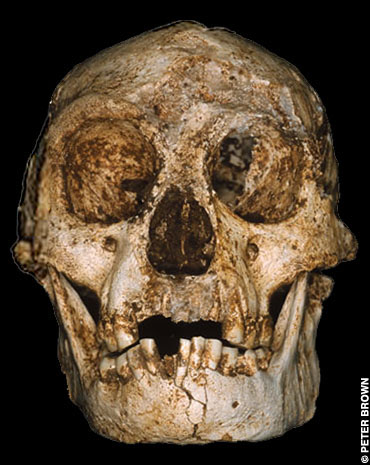
Initially, remains of seven individuals were found -- some very fragmentary. Best specimen is above and left: 3 feet/ 1m tall, female, around 30 years old, 18 000 BP. Brain: the size of a chimp's.
Found in eastern Indonesia on the island of Flores, at a cave site called Liang Bua
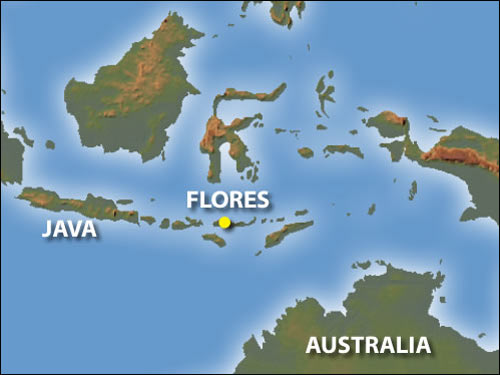
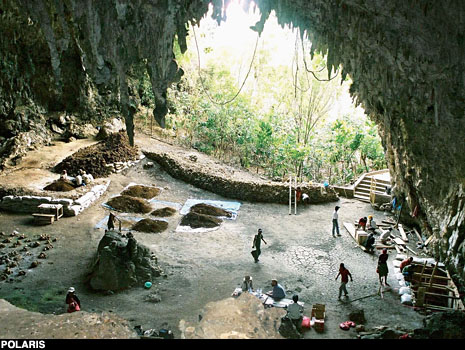
Size compared to modern H. sapiens - absolutely tiny
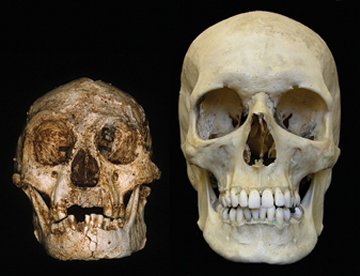

So what are they???
First, what they're NOT:
They're not "Mini-Me" or a dwarfed Homo sapiens or a known "pygmy".
If they was simply very small Homo sapiens, the Flores hominids would have all the same skeletal features ... and it doesn't. Many features are different (skull, wrist, etc.)
They're much smaller than the smallest known normal H.s. But they're not small because of recognizable pathology: for example, the actor below has achondroplasia - premature fusion of long bones, restricting height.... which would be clearly visible skeletally. The Flores hominids don't show these traits.
And they're not "Hobbits", even though that's what the press said at the time.


H. floresiensis... on the right, compared to H.s.s. and to H. erectus


H. erectus comparisons
Below: Nariokotome boy, Turkana, Africa, H. erectus ... 1.5 mya. Right: "Peking Man", China, H. erectus, 500 000 bp

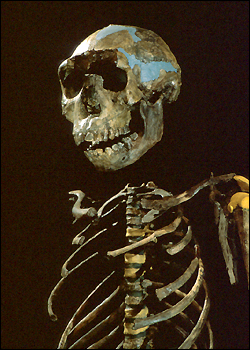
Creatures Homo floresiensis shared their world with:


Komodo Dragons, pygmy Stegodon (elephant, not dinosaur Stegadon), and the Flores Giant Rat http://www.press.jhu.edu/books/walkers_mammals_of_the_world/rodentia/rodentia.muridae.papagomys.html
Major implications
a) Extreme physical adaptation in Homo genus
Island Dwarfism: e.g. Pygmy Mammoth http://www.nps.gov/chis/pygmy.htm
b) Completely surprising very late survival of H. erectus descendants... coexistence with Homo sapiens sapiens.... so not only did we coexist with Neandertals, but also with H. erectus descendants.... profound biologically and philosophically!
c) Revision of the family tree...
d) Further research: Search of other islands for similar specimens... and a reconsideration of ethnographic evidence/folklore...


Above, From Nature: Figure 1. Homo floresiensis in the context of the evolution and dispersal of the genus Homo. The new species as part of the Asian dispersals of the descendants of H. ergaster and H. erectus, with an outline of the descent of other Homo species provided for context.

The Neanderthals... and their Disappearance
: (
Three things going on at once... or four!
Early Archaic Homo sapiens more developed than H. erectus, but clearly transitional - 400 000 to 125 000 BP? dates vary. Widespread throughout Africa, Asia, Europe. Gave rise to both us and and the Neanderthals
-Neandertals - essentially a form of late Archaic H. s. - 200 000? or conventionally, 130 000 to around 30 000 BP (maybe later), only in Europe and Middle East
Anatomically modern Homo sapiens sapiens – which is what we are – emerged in the Pleistocene epoch, maybe as early as 200 000, but definitely by around 120 000 bp.
n.b. it looks now as though we have very late H. erectus survivals too (H. floresiensis)
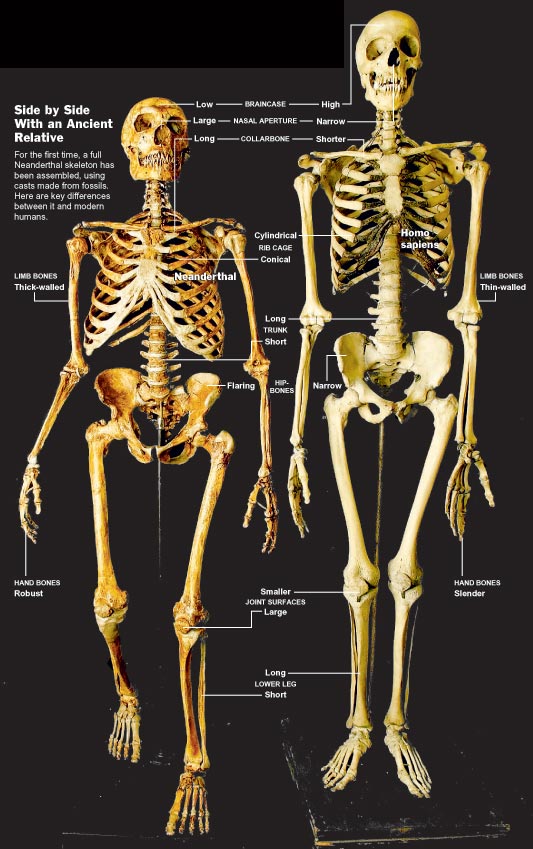
(Anatomically modern H.s.s. is defined by cranial architecture, lack of skeletal robusticity)
Images of Skulls only:
http://www.mnh.si.edu/anthro/humanorigins/ha/nead_sap_comp.html
Quicktime: http://www.pbs.org/wgbh/nova/neanderthals/skulls.html
(Consider: Why did species branch out when they did?)
What happened next???
The Neanderthals disappeared (more shortly), leaving just us... (and H. floresiensis).
But how did Anatomically Modern Humans -- us, the modern form of the human species that dates back 100 kyr or more -- emerge?
1) Earlier forms of human did leave Africa (first wave: Homo erectus, and second wave: archaic H. sapiens) and some survived a long time (e.g. Neanderthals in Europe, H. floresiensis in Indonesia)
2) But AMH (our species) are different... how did we spread around the globe?
Rebecca Cann, Allan Wilson, and Mark Stoneking published a paper in 1987, which used mitochondrial DNA to find the last ancestor that ALL living humans have in common...
- remember mtDNA is transmitted only down the maternal line, and that it mutates at a fairly stable rate... so we can trace it backwards
Conclusions of a series of mitochondrial studies: the last common ancestor to ALL living humans today lived in Africa around 150 000 years ago
Further: mitochondrial studies can also trace the expansion of AMH once they left Africa...
(a nice animation:
http://www.learner.org/channel/courses/biology/units/humev/images.html
and a pretty good series of maps: http://www.rootsforreal.com/migrations_en.php )
interesting reference: http://en.wikipedia.org/wiki/Human_mitochondrial_DNA_haplogroups
SO....
Scholars believe that Homo erectus was the first human species to spread out from Africa... and that modern humans are all one species, Homo sapiens sapiens. The data we have are clear about this. But what exactly happened in between?
There are lots of 'transitional fossils', but the challenge is making sense of the pattern of them, throughout the Old World.
SEE P 247
Multiregional Model : Homo erectus spread out from Africa, and each regional population evolved into Homo sapiens sapiens.
Recent African Origin Model / Out of Africa-2 : Homo erectus spread out from Africa. Homo sapiens sapiens evolved in Africa and then spread out over the same territory that Homo erectus had previously occupied -- replacing them.
Assimilation model: Homo sapiens sapiens evolved in Africa and then spread out over the same territory that Homo erectus had occupied -- but there was some interbreeding.